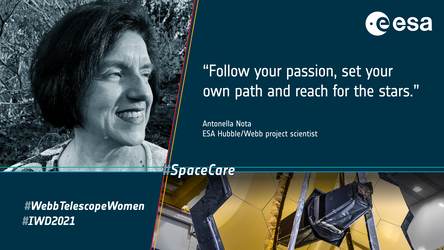Accept all cookies Accept only essential cookies See our Cookie Notice

About ESA
The European Space Agency (ESA) is Europe’s gateway to space. Its mission is to shape the development of Europe’s space capability and ensure that investment in space continues to deliver benefits to the citizens of Europe and the world.
Highlights
ESA - United space in Europe
This is ESA ESA facts Member States & Cooperating States Funding Director General Top management For Member State Delegations European vision European Space Policy ESA & EU Space Councils Responsibility & Sustainability Annual Report Calendar of meetings Corporate newsEstablishments & sites
ESA Headquarters ESA ESTEC ESA ESOC ESA ESRIN ESA EAC ESA ESAC Europe's Spaceport ESA ESEC ESA ECSAT Brussels Office Washington OfficeWorking with ESA
Business with ESA ESA Commercialisation Gateway Law at ESA Careers Cyber resilience at ESA IT at ESA Newsroom Partnerships Merchandising Licence Education Open Space Innovation Platform Integrity and Reporting Administrative Tribunal Health and SafetyMore about ESA
History ESA Historical Archives Exhibitions Publications Art & Culture ESA Merchandise Kids Diversity ESA Brand Centre ESA ChampionsLatest
Space in Member States
Find out more about space activities in our 23 Member States, and understand how ESA works together with their national agencies, institutions and organisations.
Science & Exploration
Exploring our Solar System and unlocking the secrets of the Universe
Go to topicAstronauts
Missions
Juice Euclid Webb Solar Orbiter BepiColombo Gaia ExoMars Cheops Exoplanet missions More missionsActivities
International Space Station Orion service module Gateway Concordia Caves & Pangaea BenefitsLatest
Space Safety
Protecting life and infrastructure on Earth and in orbit
Go to topicAsteroids
Asteroids and Planetary Defence Asteroid danger explained Flyeye telescope: asteroid detection Hera mission: asteroid deflection Near-Earth Object Coordination CentreSpace junk
About space debris Space debris by the numbers Space Environment Report In space refuelling, refurbishing and removingSafety from space
Clean Space ecodesign Zero Debris Technologies Space for Earth Supporting Sustainable DevelopmentLatest
Applications
Using space to benefit citizens and meet future challenges on Earth
Go to topicObserving the Earth
Observing the Earth Future EO Copernicus Meteorology Space for our climate Satellite missionsCommercialisation
ESA Commercialisation Gateway Open Space Innovation Platform Business Incubation ESA Space SolutionsLatest
Enabling & Support
Making space accessible and developing the technologies for the future
Go to topicBuilding missions
Space Engineering and Technology Test centre Laboratories Concurrent Design Facility Preparing for the future Shaping the Future Discovery and Preparation Advanced Concepts TeamSpace transportation
Space Transportation Ariane Vega Space Rider Future space transportation Boost! Europe's Spaceport Launches from Europe's Spaceport from 2012Latest

#WebbTelescopeWomen Emily Rickman
Thank you for liking
You have already liked this page, you can only like it once!
Emily Rickman, ESA Research Fellow
What is your role in Webb?
I hunt for planets outside of our Solar System, known as exoplanets, by taking high-contrast images using some of the largest telescopes in the world, and in the future using instruments on Webb. I also work on the commissioning of the NIRSpec spectrograph onboard Webb.
Why are you excited about Webb?
Webb will observe in a wavelength range that is not easily accessible from the ground, which will be vital in looking at the atmospheres of giant exoplanets to provide clues and solve mysteries as to how cold gas giants (like Jupiter) formed and evolved.
What has been the highlight of your career so far?
Discovering a brown dwarf (an object more massive than a planet, but less massive than a star) through high-contrast imaging. Brown dwarfs can act as analogues to understand the atmospheres of giant planets because they possess similar atmospheric properties. The brown dwarf I directly imaged is only the fourth known brown dwarf of its spectral type with both observations of radial velocities of its host star and relative astrometry from direct imaging, and therefore the true dynamical mass of this brown dwarf is known. This means that it serves as a ‘benchmark’ object in which to compare atmospheric and evolutionary models of brown dwarfs and giant exoplanets in order to better understand these objects. I remember seeing the image of the brown dwarf for the first time and thinking, “no one else on Earth has seen this except me.” It was a strange moment of bliss before sharing it with my collaborators.
Did you have a mentor during your career, and if so, how did they inspire you?
It’s difficult for me to single out one person because I have felt so lucky to have had so many great role models and mentors throughout my career. Looking up to women in science in more senior positions than me definitely made me feel like “if they can do it, then I can do this too.”
What advice could you offer to young people thinking of pursuing a career in STEM?
Don’t let anyone ever tell you that you don’t belong. There is space for everyone in STEM careers. There are so many interesting career paths in STEM, so find your passion in something that you enjoy and follow it.
The 2021 International Women’s Day theme is “Choose to Challenge”. What are the biggest challenges you’ve fought to overcome in your career?
There have been many moments where I have been the only woman in the room, and felt like I didn’t belong there, or that my opinion wasn’t valued as much as my male peers. Whenever this feeling arises, I swallow it and make sure that my voice is heard. That can be difficult, but it’s getting easier each time.
-
CREDIT
ESA; Northrop Grumman; portrait supplied by contributor -
LICENCE
ESA Standard Licence

#WebbTelescopeWomen Elena Manjavacas

#WebbTelescopeWomen Giovanna Giardino

#WebbTelescopeWomen Antonella Nota

#WebbTelescopeWomen Macarena Garcia Marin















 Germany
Germany
 Austria
Austria
 Belgium
Belgium
 Denmark
Denmark
 Spain
Spain
 Estonia
Estonia
 Finland
Finland
 France
France
 Greece
Greece
 Hungary
Hungary
 Ireland
Ireland
 Italy
Italy
 Luxembourg
Luxembourg
 Norway
Norway
 The Netherlands
The Netherlands
 Poland
Poland
 Portugal
Portugal
 Czechia
Czechia
 Romania
Romania
 United Kingdom
United Kingdom
 Slovenia
Slovenia
 Sweden
Sweden
 Switzerland
Switzerland

























